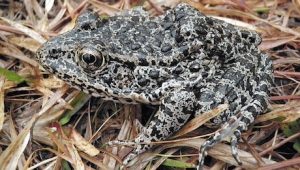By Michael Bastasch
A property rights case involving an endangered frog could end up being the first case heard by Judge Brett Kavanaugh, President Donald Trump’s pick to replace Supreme Court Justice Anthony Kennedy.
If confirmed in time, Kavanaugh would hear oral arguments for Weyerhaeuser Company v. U.S. Fish and Wildlife Service. The high court is scheduled to hear the Endangered Species Act (ESA) on Oct. 1.

The Dusky Gopher Frog is about three inches long, has a stocky body, and features colors ranging from black to brown to gray. It also has dark spots and is covered in warts.
While most of the focus has been how potential nominees would rule on hot-button issues like abortion and affirmative action, the new justice’s first oral arguments will be over the federal government’s authority under the ESA.
The Weyerhaeuser case presents the court with two questions: Does the Endangered Species Act prohibit the federal government from designating land where the animal in question doesn’t live as habitat necessary for its survival? And, is the federal agency’s decision to exclude lands from habitat listings due to economic impacts subject to judicial review?
FWS officials designated 1,500 acres of private lands in Louisiana as critical habitat for the dusky gopher frog, despite the amphibian not currently living on those lands. Landowners could end up paying millions to make the land habitable for the dusky gopher frog.
The Supreme Court took up the case in January, and since amicus briefs have been filed on the case. A federal appeals court refused to rehear the challenge to FWS’s critical habitat listing in early 2017.
Environmentalists want the court to uphold the designations while property rights advocates argue designating unoccupied land as critical habitat violates federal law.
St. Tammany Parish, where the private lands are located, argued FWS’s decision would take economic decisions out of the lands of local officials and deprive local government of valuable tax revenues.
 “The said property has previously been zoned for development as a Traditional Neighborhood and the designation as a ‘Critical Habitat’ will adversely effect same,” parish attorneys wrote in their amicus brief.
“The said property has previously been zoned for development as a Traditional Neighborhood and the designation as a ‘Critical Habitat’ will adversely effect same,” parish attorneys wrote in their amicus brief.
Critical habitat designations can keep lands off-limits to development by adding new layers of federal permitting and red tape.
Federal officials listed the dusky gopher frog under the ESA in 2001 in response to a petition from the environmental group the Center for Biological Diversity. Officials said Poitevent family land is among the last known dusky gopher frog habitats in Louisiana.
Content created by The Daily Caller News Foundation is available without charge to any eligible news publisher that can provide a large audience. For licensing opportunities for this original content, email licensing@dailycallernewsfoundation.org.



FWS officials designated 1,500 acres of private lands in Louisiana as critical habitat for the
dusky gopher frog, despite the amphibian not currently living on those lands………What !!
So there are “NO” signs of the frogs living in these 1500 acres, maybe the frogs found a better
place to live ??
One would think that the FWS would understand that animals move to where they feel more
comfortable living …………….. More wasted Federal funds being wasted in the courts !!
Shameful …………
Agreed, stupid is more like it.
It may appear “shameful” but TNP is intentionally distorting the truth, as per usual. The fact is that there are less than 100 of these frogs left in existence and they require a very specific habitat to survive. Designating lands as “critical habitat” for endangered species does not necessarily mean those lands can not be developed. It merely starts a process to help local planners determine areas that should be considered for conservation to protect habitat. In this case, the hope is to identify specific areas where the frog could be re-introduced. IN one case in Mississippi, a land trust was able to purchase a small tract of land to protect frog habitat. The 1500 acres referenced in this article contain several smaller areas ideal for frog re-introduction. Why not try to work with the landowner/developer to potentially conserve these small wetlands so the species can survive?